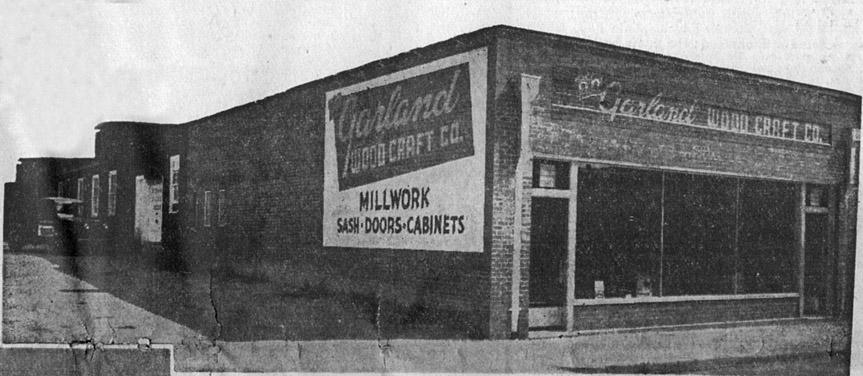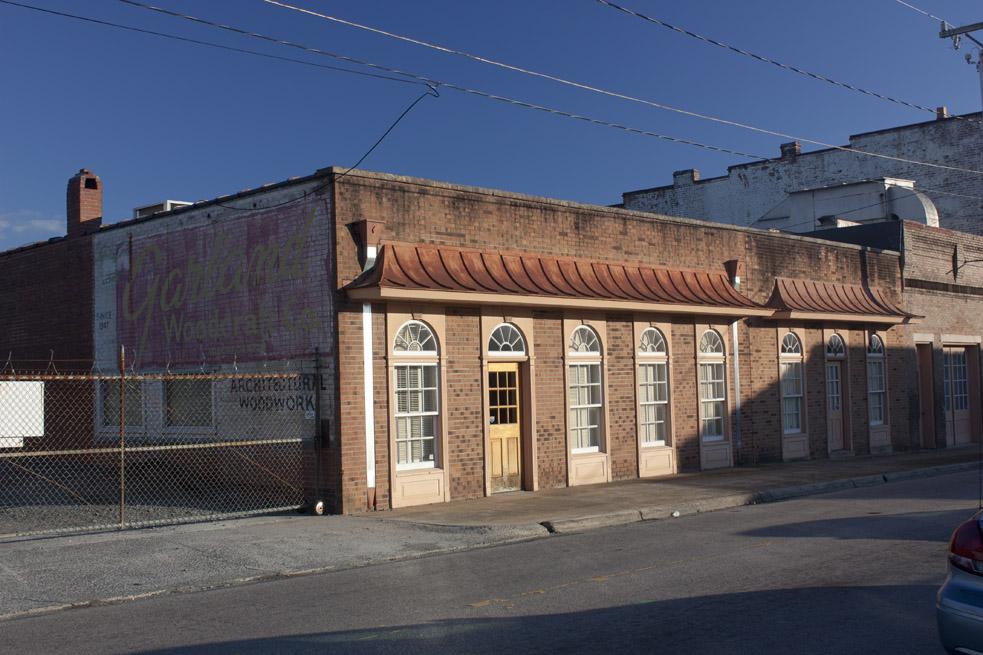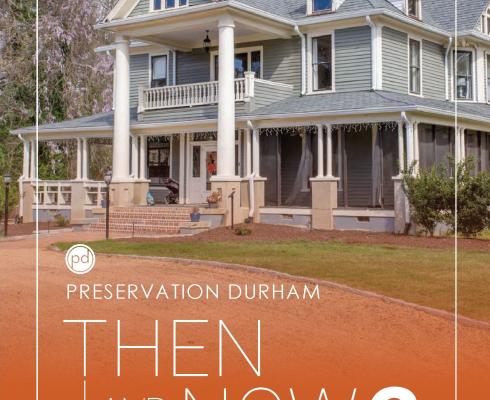455 S Driver, 1953
(The information below in italics is from the Preservation Durham Plaque Application for the O.K. Proctor Building)
It would appear from this evidence that the three-bay brick building at the corner of South Driver Street and Pettigrew was built around 1905 (However, I admit that I am taking this from Gary’s conclusion in Open Durham. The earliest possible reference I found was in the 1907-8 city directory). The property was owned by Oswell Kinion Proctor, Jr. He was a director of the People’s Bank, the primary and corner tenant of the building. In time Proctor would become its vice-president. O. K. Proctor, Jr., was born in 1859. His father, Oswell, Sr., was born in 1827 and died in 1863 while in Confederate service. Oswell., Jr., had five brothers and sisters. They were all grandchildren of Richard Anthony Proctor – an original land-grant recipient in Orange County. From Richard Proctor sprang many Proctor lines in Durham. Oswell K. Proctor, Jr., married his cousin, Mary E. Barbee, in 1883. The Proctors were farmers originally, with large holdings, but as Durham began to grow, they branched out into other businesses, including banking and real estate development. Oswell, Jr., owned a farm in East Durham. In the 1890s, he began to buy up property in the block described by Angier Avenue, Proctor Street (now Salem), the railroad, and Driver Avenue (now Driver Street). Sanborn maps indicate that at the time, much of the property was occupied by single-family frame houses.
The People’s Bank was organized in the early years of the 20th Century. Its first officers were Y. E. Smith, president, J. B. Mason, Vice-president, and J. W. Wilkerson, cashier. In addition to these men, the original board of directors included C. A. Crabtree, T. H. Alford, Oswell K. Proctor, R. G. Jones, Ellerbe Powe, Jesse Harper Erwin, W. C. Jones, and R. H. Lewis, Jr. It appears that the bank was organized to serve millhands and factory workers. Its location across the tracks from the textile mill was no accident. Oswell K. Proctor, Jr., was associated with the bank during its entire existence.
In the ‘teens, during the great progressive period, Oswell K. Proctor, Jr., offered 15 acres of land near Miami Boulevard to be used as an orphans’ asylum. It was to be called Joyland. No institution was ever created, but the name stuck.
Oswell K Proctor, Jr., and Mary had no children of their own. Oswell died in 1923. His widow, Mary, became the sole owner of the O. K. Proctor holdings across east Durham. When she died in 1930, much of her land passed to their nephews, C. K. Proctor, S. L. Proctor, B. G. Proctor, and J. H. Proctor. At some point, the South Driver Avenue property was mortgaged by these men. When the loan went into default in 1936, it was sold in foreclosure. It was purchased by the Joyland Development Corporation, a company formed by the Proctors to develop the former, would be orphanage site. The company paid $39,000 for the property. Joyland sold the property to Crown Investment Company, a partnership composed of A. B. Stone, Jr., D. E. Brady, and Ralph Ripley.
In the course of its history, Durham has had several Proctor Streets. The one that has survived is in the Morehead Hill neighborhood. What is now Salem Street in East Durham was called Proctor Street from the 1890s until East Durham was incorporated into Durham proper in the 1920s.
Members of the Oswell K. Proctor family are buried in the Proctor Cemetery on Hoover Road near Joyland in East Durham. Oswell Proctor, Sr., is buried in Goldsboro with other Confederate dead.
Kinion is pronounced “Kin’yun.”
455 South Driver, 10.02.10
The rear portion of this property was developed in the late 1940s as Garland Woodcraft; when the building on South Driver was constructed is unclear - but after 1950. The business, which now takes up the remainder of the block south to Peabody, remains active as of 2011.
++
(Below in italics is from the 2004 East Durham National Register listing; not verified for accuracy by this author.)
1-story flat-roofed brick office building, 8 bays wide, with 2 doors and 6-over-6 wooden sash windows with fanlights that are examples of the millwork of Garland Woodcraft Company, who constructed this as offices. The company, owned by A.B. Stone, Ralph Ripley, bought the lumber yard of Garland Haithcock, that stood on this site ca. 1945 and built this building soon after. The facade was replaced about 1970, making the building noncontributing. Extending from the rear of the building is the wood shop complex, consisting of five sections added at different times, but all connected. Directly to the rear is a 1-story frame gabled woodshop. Two additional gabled frame woodshop wings are attached to the south side of this. To the east (rear) is a 2-story concrete block warehouse for rough products. To the north extends a 2-story finished products warehouse, with some exposed concrete block walls and some metal walls. 1945 CD: Garland Woodcraft Cabinetmakers No. 451-453.
NC Garage. Ca. 1960. Located behind the finished products warehouse is a 1-story concrete block garage.
[Update 5/2023] Write-up from the Preservation Durham Home Tour "Then & Now: Part II"
Just a few years ago, the southern end of South Driver Street in East Durham was likely not your destination - unless you needed a mortuary, which isn’t often, if you are lucky. Had you driven southward from Angier, down toward the tracks - perhaps on your way to Hanes Funeral Services - you would have seen across the street a row of decrepit brick buildings, one with its upper windows boarded closed, paint and plaster peeling, roof partially caved in, and a second floor suffering structural damage from water and exposure. A section of the building which housed Garland Woodcraft, had been badly damaged by fire in late 2016. So, to the casual observer, the property did not look like it had much to offer. Fortunately, those with keener vision recognized both its history and its promise.
Architects John Warasila, AIA, and Vandana Dake with Alliance Architecture partnered with Matt Thompson, who, in 2018, had acquired the buildings and the millwork business located there. Thompson had dreamed of revitalizing the block, convinced that both the buildings and the neighborhood were worthy of investment. He formed Garland Ventures, LLC, to pursue that goal. Warasila and his partners shared Thompson’s excitement and joined in, first as investors, and later as owners and developers. They arrived in East Durham fresh from finishing a major rehabilitation project at Golden Belt, a mile away, and were thrilled to take on what Thompson had started, eventually buying Garland Ventures.
Our vision is to use these structures to anchor what can be a new ‘main street’ along South Driver, connecting the block, corner to corner,” Warasila says.
The team’s mission in revitalizing historical buildings involves respecting a property’s architectural integrity and honoring its history, while also inspiring local engagement and employing local entrepreneurial talent. One way to avoid displacing neighbors, Warasila knows, is to involve the neighborhood. Businesses for the buildings are already lined up and hoping to be in by summer. Mike D’s BBQ will have a retail store for his award-winning sauces and all things barbeque, and this location will also offer take-out. The owner of Rofhiwah Book Café - just up the street on the southwest corner of South Driver and Angier (in the historic Seagroves Grocery store building) - will open Congress, a bar for the neighborhood to “come together;” next door - oysters and dumplings, with Proximity Brewing Company, one of the growing number of black-owned breweries in the state, landing in the corner space.
We want it to be a diverse neighborhood of makers, brewers, chefs, potters, sculptors, with, eventually, residential on second floors,” Warasila says.
In 2021, Claymakers, a ceramics center and school, relocated just around the corner, on Salem Street. A fixture near Central Park for twenty years, the arts community was Garland Venture’s first tenant. Alliance’s plan is to make the block buzz again.
There was a time, long ago, when this southern block of Driver Street was indeed a bustling business center. In the mid 1890’s, a meat market, bootmaker, general store and confectionery stood in wood-frame buildings just a stone’s throw from the Southern railroad platform across the tracks from the Durham Cotton Manufacturing Company. By 1907, the corner commercial district would be anchored by a handsome two-story buff brick bank, flanked by a post office, with an assortment of other customer focused businesses supplying everything from sandwiches to shoes, drugs to dry goods. There were two barbers to choose between. As other industries – lumber yards, fertilizer, and buggy factories - established themselves along the southeast Durham railroad corridor, workers and suppliers settled in the neighborhood. In 1902 the trolley line extended to East Durham - not yet part of Durham proper - heading east along Angier Avenue, turning up Driver Street (then Driver Ave) and back to town along Holloway. The commercial hub relocated further up South Driver to the corner with Angier, and by 1921 People’s Bank had moved north from its original spot down by the tracks to the corner of Angier and Driver to become the East Durham branch of the Fidelity Bank - another historic landmark in the neighborhood. Nonetheless, the little brick business center by the railroad tracks chugged along, even after the Durham Cotton Manufacturing company closed in 1937, the trolley shut down, and customers moved north and west.
The People’s Bank building, at 459-461 S Driver, frequently listed as 463, was constructed circa 1905. Described in the 2004 national register of historic places nomination as having “an elegant Neoclassical Revival design with a diagonal corner entrance and arched upper façade windows,” it was said to resemble the early twentieth century commercial buildings of central Durham, many of which no longer stand. After the bank moved up the street, the building housed a grocery store, with a men’s private organization meeting above in the space formerly used by Aubrey Wiggins’ cleaning and pressing business. Next to that was first a drug store, then a sandwich shop, (Royal’s followed by Ellis’s) at 461. Later the East Durham post of the Salvation Army moved next door to the bank building, as did a diaper supply service. In a few years the Salvation Army moved upstairs, and the downstairs hosted first a bottling company, then a hosiery mill and manufacturing company, and, by 1960, a sales agency.
Although there are four connected historic structures, (with six cumulative street numbers) one is considered non-contributing to the historical district because its façade was replaced around 1970; nonetheless, that building is still part of the larger renovation project. The one story brick office building, eight bays wide, was built around 1945 and became the long-time home of Garland Woodcraft Cabinetmakers, named after Garland Haithcock who had operated a lumber yard on the site. Garland’s original owners, A.B. Stone and Ralph Ripley, bought the lumberyard and built their offices with an extensive wood shop and warehouses beside and behind. Between the office building at the north end, and the bank building at the southern end, stands another one-story buff brick building with its original façade and a paneled and corbeled cornice. In 1930, Walter J Williams ran the Home Cash Store Grocery here, and later it was the new site for the East Durham Post Office. Garland bought the building sometime after 1947. The company, whose address has been listed variously as 451/453/455 South Driver, outlasted all the other tenants. It eventually owned or was using all the buildings on the east side of the street in some capacity for their business. Garland was known throughout the triangle and beyond for detailed custom woodworking, and their millwork can still be found in buildings and houses across Durham, including many Duke University buildings. The shop reportedly built the North Carolina House Chamber’s podium and gavel, which had to be hollowed just right to elicit a thump with sufficient gravitas. Garland renovated the porches on the North Carolina governor’s mansion, replacing the antique posts with handmade replicas. In their own neighborhood, Garland contributed to the major rehabilitation of East Durham’s historic Y.E. Smith School, by restoring hundreds of feet of deteriorated paneling for what is now the Maureen Joy Charter school. The business remained in its home on South Driver for almost seventy-five years.
By the time John Warasila and his partners entered the picture in 2021, South Driver’s brick business block was dilapidated. An eight-foot hole in the bank building roof had exposed the interior to the elements and the upstairs floor had become unsound. The red brick façade on the eastern side had extensive masonry damage and was failing. Yet, in spite of the obvious deterioration, the buildings retained enough of their original details to offer glimpses of what they had been and what they still could be: The exterior corbeled masonry cornices were grimy but intact, and interior original ceramic tile floors of the bank lobby were largely undamaged, as were the terrazzo floors in the other two building sections - albeit covered with decades of dirt and debris. And although the southern exterior wall appeared as a vast expanse of deteriorating plastered masonry, the owners discovered a pattern of full-length windows seen only from the inside - six windows above and six below - that had been covered over. The chamfered southwest corner of the building which had served as the bank’s formal entrance still retained its original multi-light, four-over-four, transom above the door, with a pattern of interlocking bricks running vertically to create the bevel. On the upper portion of the western side (facing Driver Street), there were intact openings for the original ten arched windows. Below, were three large store-front windows. Even though two of the three storefront windows were partly filled with brick, all of these openings could be restored. And the team made an especially fun find upstairs. Once they dismantled office partitions, the owners uncovered four painted floor-to-ceiling wood columns with square bases and round shafts, approximately 10’’ in diameter, undamaged and still load-bearing. All of the columns would be retained.
Garland Ventures hired Durham-based Gateway Building Company as general contractors and construction managers. Together they launched the process of rehabilitation. The project received approval from the state historic preservation office which requires a lengthy detailed application procedure. The job was monumental as such historical restorations always are; retaining the historical integrity of the structures while modernizing the spaces requires patience and painstaking craftsmanship. Due to deterioration from age and exposure, very little of the interiors could be salvaged; the painted bead board ceiling and the tongue and groove flooring on the second floor were both beyond repair and have been replaced with the same material. Any wood trim that could be saved was repaired and re-used. Most of the existing windows themselves were not original and all were in poor condition. They were all removed and replaced with new frames and glazing compatible with double-hung windows of the period. Doors were also replaced, with historically appropriate replicas. Most of the interior walls were solid masonry with plaster coating which was damaged throughout - but anywhere it was intact, the surface plaster was retained and repaired. The entire electrical system had to be replaced as the old one was no longer compliant or even functioning. New HVAC and plumbing systems were installed, and new bathrooms were built to replace the single, antiquated toilet and sink.
Outside, the roof was reframed and replaced and the failing gutters torn out. Insulation was added, and asbestos was carefully removed. The east-side exterior wall that had caved in was rebuilt, and repointing was completed with matching mortar. Each of the failing row-locked window arches, also on the east side, were restored. And that vast two-storied wall of worn plaster facing the railroad tracks? Once all twelve windows were uncovered and restored, the wall was newly stuccoed. Now it looks much like it must have almost 120 years ago.
To tie the whole project together, a landscaped courtyard will extend behind the businesses with room for tables and sitting areas. Concrete from the old driveway - along with interior concrete slabs removed to make way for new plumbing - were cut into 30’’x 30’’panels to be reused as landscape pavers. And, as a nod to Garland’s long legacy at the location, the owners retained Ben Sheely with Bampro to fabricate a custom iron gate incorporating salvaged saw and tool parts from Garland’s defunct equipment. The gate stands in what was the old store front window of 457 S Driver, now another shared courtyard between the new businesses. Soon enough the train whistle will have to compete with live music and laughter as the sound of life down on South Driver. The block is back.
Find this spot on a Google Map.
35.980367,-78.878812




Comments
Submitted by Vivian Taylor Briggs (not verified) on Mon, 6/13/2011 - 2:00am
Mr. Henry Overman's store used to be across the street from Garland Woodcraft. The workers used to go to his store to buy five cent drinks and home made barbeque sandwiches. If my sister and I were there visiting Mr.Overman, the workers would give us Maryjanes.-Vivian Taylor Briggs
Submitted by Vivian Taylor Briggs (not verified) on Mon, 6/13/2011 - 4:04am
Mr. Henry Overman's store used to be across the street from Garland Woodcraft. The workers used to go to his store to buy five cent drinks and home made barbeque sandwiches. If my sister and I were there visiting Mr.Overman, the workers would give us Maryjanes.-Vivian Taylor Briggs
Add new comment
Log in or register to post comments.